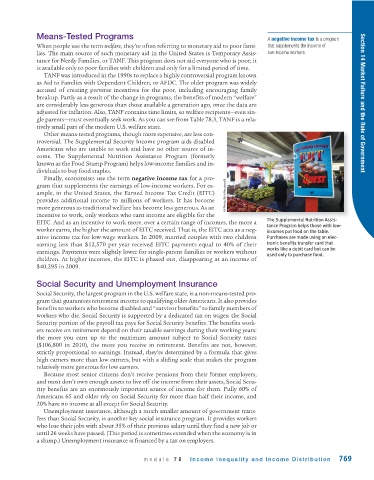Page 811 - Krugmans Economics for AP Text Book_Neat
P. 811
Means-Tested Programs A negative income tax is a program
When people use the term welfare, they’re often referring to monetary aid to poor fami- that supplements the income of
lies. The main source of such monetary aid in the United States is Temporary Assis- low-income workers.
tance for Needy Families, or TANF. This program does not aid everyone who is poor; it
is available only to poor families with children and only for a limited period of time.
TANF was introduced in the 1990s to replace a highly controversial program known
as Aid to Families with Dependent Children, or AFDC. The older program was widely
accused of creating perverse incentives for the poor, including encouraging family
breakup. Partly as a result of the change in programs, the benefits of modern “welfare”
are considerably less generous than those available a generation ago, once the data are Section 14 Market Failure and the Role of Government
adjusted for inflation. Also, TANF contains time limits, so welfare recipients—even sin-
gle parents—must eventually seek work. As you can see from Table 78.3, TANF is a rela-
tively small part of the modern U.S. welfare state.
Other means-tested programs, though more expensive, are less con-
troversial. The Supplemental Security Income program aids disabled
Americans who are unable to work and have no other source of in-
come. The Supplemental Nutrition Assistance Program (formerly
known as the Food Stamp Program) helps low-income families and in-
dividuals to buy food staples.
Finally, economists use the term negative income tax for a pro-
gram that supplements the earnings of low-income workers. For ex-
ample, in the United States, the Earned Income Tax Credit (EITC) AP Photo/Rich Pedroncelli
provides additional income to millions of workers. It has become
more generous as traditional welfare has become less generous. As an
incentive to work, only workers who earn income are eligible for the
The Supplemental Nutrition Assis-
EITC. And as an incentive to work more, over a certain range of incomes, the more a
tance Program helps those with low-
worker earns, the higher the amount of EITC received. That is, the EITC acts as a neg- incomes put food on the table.
ative income tax for low-wage workers. In 2009, married couples with two children Purchases are made using an elec-
earning less than $12,570 per year received EITC payments equal to 40% of their tronic benefits transfer card that
works like a debit card but can be
earnings. Payments were slightly lower for single-parent families or workers without
used only to purchase food.
children. At higher incomes, the EITC is phased out, disappearing at an income of
$40,295 in 2009.
Social Security and Unemployment Insurance
Social Security, the largest program in the U.S. welfare state, is a non-means-tested pro-
gram that guarantees retirement income to qualifying older Americans. It also provides
benefits to workers who become disabled and “survivor benefits” to family members of
workers who die. Social Security is supported by a dedicated tax on wages: the Social
Security portion of the payroll tax pays for Social Security benefits. The benefits work-
ers receive on retirement depend on their taxable earnings during their working years:
the more you earn up to the maximum amount subject to Social Security taxes
($106,800 in 2010), the more you receive in retirement. Benefits are not, however,
strictly proportional to earnings. Instead, they’re determined by a formula that gives
high earners more than low earners, but with a sliding scale that makes the program
relatively more generous for low earners.
Because most senior citizens don’t receive pensions from their former employers,
and most don’t own enough assets to live off the income from their assets, Social Secu-
rity benefits are an enormously important source of income for them. Fully 60% of
Americans 65 and older rely on Social Security for more than half their income, and
20% have no income at all except for Social Security.
Unemployment insurance, although a much smaller amount of government trans-
fers than Social Security, is another key social insurance program. It provides workers
who lose their jobs with about 35% of their previous salary until they find a new job or
until 26 weeks have passed. (This period is sometimes extended when the economy is in
a slump.) Unemployment insurance is financed by a tax on employers.
module 78 Income Inequality and Income Distribution 769

